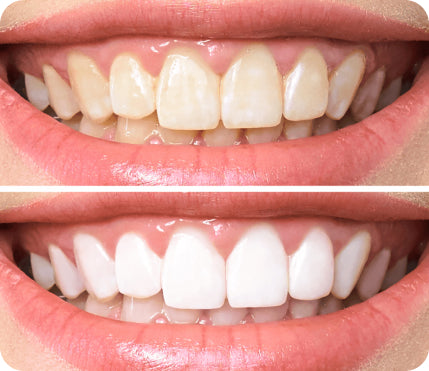
All products are certified by dental expert Dr. Greg Grillo
Having yellow teeth can be a real confidence killer, and cavities can make things even worse. It's natural to want to whiten your teeth, but is it possible if you have cavities? This article delves into how you might be able to make that happen.
Cavities are a problem that affects nearly every adult at some point. With around 90% of the adult population affected, it's not something to be ashamed of.
Unfortunately, one of the main causes of cavities is poor oral hygiene, which can also result in yellow teeth.
Teeth whitening is an increasingly popular and relatively affordable way of addressing this problem. But is it possible to do so if you have cavities?
Let's take a closer look.
Can You Get Teeth Whitening With Cavities?
The short answer is yes. Cavities don't affect your candidacy for teeth whitening, but addressing the underlying dental issues first is essential. You have to fix your cavities before starting the teeth whitening process.
Whether you use in-office (professional) whitening treatment or use at-home teeth whitening products, the same rule applies: get your cavities filled first.
Attempting to whiten teeth with active cavities can cause further damage and pain. Here's a step-by-step approach to ensuring you're ready for teeth whitening:
1. Consult With A Dentist
Before embarking on any teeth whitening journey, it's essential to consult with your dentist, especially if you think you have a cavity.
Your dentist will thoroughly examine your teeth and gums, evaluate your oral health, and identify any issues that need to be addressed before teeth whitening can be considered.
They will ask you questions regarding your symptoms, including headaches, sensitivity, and pain. They will also take X-rays to determine the severity of your cavity problem before proceeding with any filling treatment.
2. Address Cavities And Tooth Decay
Once your dentist has identified any cavities or tooth decay, it's crucial to prioritize their treatment before considering teeth whitening.
Typically, your dentist will fill the cavities with a composite material such as resin, ceramic, or glass. The cost of cavity fillings will vary depending on the location and severity of your cavities and the type of material used.
In severe cases, this may involve dental fillings, root canal treatment, or even tooth extraction.
However, these instances also require more immediate attention. And whitening your teeth before treating them could result in serious damage.
3. Choose The Right Teeth Whitening Method
With your cavities treated and your oral health in check, your dentist will be able to discuss different teeth whitening options. There are several methods available, each with its own set of advantages and drawbacks:
-
Professional in-office treatments: These are the most effective and fastest option but can also be the most expensive. Your dentist will apply a high-concentration bleaching gel to your teeth, often using a light or heat source to speed up the process.
-
Dentist-supervised at-home whitening kits: These kits contain a lower bleaching agent concentration than in-office treatments, but they're still more potent than over-the-counter options. Your dentist will provide custom-fitted trays and instructions on how to use the kit at home.
-
Over-the-counter products: OTC teeth whitening products include whitening strips, gels, toothpaste, and rinses. While they're the most affordable and widely available option, they typically deliver more modest results compared to professional treatments.
- Veneers: Some people choose to get veneers to whiten their teeth. Getting veneers with cavities isn't possible, but once your cavities are treated and you're ready to whiten your teeth, veneers are a more permanent (and less affordable) option.
Your dentist will help you choose the best option for your specific situation, considering factors like the extent of discoloration, your oral health history, and sensitivity levels.
4. Follow Proper Aftercare Instructions
Once your teeth have been whitened, it's essential to follow your dentist's aftercare instructions to maintain your charming new smile and prevent future cavities.
Here are a few crucial tips:
-
Avoiding certain foods and beverages that can stain your teeth, such as coffee, tea, red wine, and dark-colored berries.
- Staying away from foods that cause cavities, such as sticky candy, sugar-filled drinks, and highly processed snacks.
- Practicing good oral hygiene by brushing twice a day, flossing daily, and using mouthwash with fluoride.
- Scheduling regular dental check-ups and cleanings to keep your teeth and gums in optimal condition.
Sticking to these habits will ensure your teeth show minimal side effects from teeth whitening and remain cavity-free.
What Happens If You Whiten Your Teeth Before Getting Rid Of Cavities?
If you whiten your teeth before getting rid of cavities, you may experience one or more of the following symptoms:
- Increased pain from your cavities
- Higher levels of tooth sensitivity after whitening
- Damage to the enamel and dentin layers of your teeth
- The possibility that your teeth will become more discolored instead of brighter
Depending on the type of teeth whitening product you use and the duration you use it, your risk for these side effects increases.
Once you have your cavities filled, the risk of these problems is mostly eliminated, as long as you follow your dentist's instructions.
Want to learn more? Here are the questions our customers ask us the most.
How Can I Hide Cavities On My Front Teeth?
If you have a cavity on your front tooth, your immediate reaction will be to find ways to fix it.
It's important to note that hiding cavities is not a long-term solution, and seeking professional dental care is always the best course of action.
But if you're looking for a temporary solution to conceal cavities on your front teeth, here are a few options:
-
Dental wax: Orthodontic or dental wax can be applied to the cavity to cover it temporarily. This wax is typically used to protect cheeks and gums from braces' wires and brackets but can be molded to temporarily fill in small cavities. It can trap food particles and bacteria, but it works as a short-term solution that prevents the smell of cavities from permeating.
-
Temporary filling material: Over-the-counter temporary filling materials, such as dental cement or tooth repair kits, can be used to fill in cavities temporarily. These materials are not meant to replace professional dental care but can provide short-term relief until you can see a dentist.
-
Dental bonding: Although this is not a DIY solution, dental bonding is a professional cosmetic treatment that can help conceal cavities on front teeth. Your dentist will apply a tooth-colored composite resin to the affected area, sculpt it to match your tooth's shape, and harden it using a special light. This option not only hides the cavity but also strengthens the tooth structure.
- Veneers: Dental veneers are another professional solution to consider. These thin, custom-made porcelain or composite shells are bonded to the front of your teeth, effectively hiding cavities and other imperfections. Veneers can provide a long-lasting solution to improve your smile but may require some tooth preparation before placement.
Remember, these solutions are not substitutes for proper dental care. Cavities can lead to more severe dental problems, such as tooth pain, infection, and even tooth loss if left untreated.
Can You Use Whitening Strips With Cavities?
You should not use teeth whitening strips while you have a cavity for the following reasons:
-
Increased sensitivity: The whitening agents in the strips can penetrate the cavities and reach the sensitive inner layers of the tooth, causing increased sensitivity during and after the whitening process.
-
Uneven whitening: Cavities and decay can interfere with the whitening process, leading to uneven results. The healthy portions of your teeth may become whiter, while the areas with cavities might remain discolored.
-
Risk of infection and further damage: Using whitening strips on teeth with cavities can exacerbate existing dental problems. The chemicals in the strips may irritate the decayed areas, increasing the risk of infection and further damage to the tooth.
- Ineffective treatment: In some cases, using whitening strips on teeth with cavities can make the treatment less effective overall. The whitening agents may not be able to penetrate the discolored areas caused by decay as effectively as they would on healthy teeth.
Does Teeth Whitening Cause Cavities?
Teeth whitening itself does not cause cavities, but it can make existing cavities more noticeable. The bleaching agents used for the whitening process can penetrate the enamel and reach deeper layers of the tooth, highlighting discolored areas such as cavities. Since cavities can hurt, whitening treatments may increase sensitivity or discomfort when exposed to hot or cold temperatures.
Should I Have Cavities Filled Before Teeth Whitening?
You should always have cavities filled before undergoing any form of teeth whitening. Since the bleaching agents can penetrate the tooth and reach the sensitive inner layers, they can worsen existing dental problems and increase pain or sensitivity. Additionally, because cavities interfere with the bleaching process, your results may be uneven if you try to whiten teeth with cavities.
Is Teeth Whitening Appropriate For Teeth With Cavities?
Whether or not teeth whitening is a good idea for people with cavities depends on whether the cavity is treated or untreated. If the cavity is treated, there should be no issue with teeth whitening. If the cavity is untreated, it’s best to avoid teeth whitening until the problem is resolved.
Do Whitening Strips Hurt Cavities?
Teeth whitening strips can cause discomfort in people with cavities. The bleaching agents used in the strips can penetrate holes in your oral cavity, meaning they can reach the inner, sensitive layers of the tooth. When hot or cold food touches these areas, it will cause pain and sensitivity, so it’s best to avoid whitening strips if you have cavities.
Wrapping Up
Teeth whitening with cavities is possible, but patients always need to treat their cavities before whitening.
Even when completed under dental supervision, teeth whitening procedures for people with cavities can still lead to increased sensitivity and discomfort.
If you think you have a cavity, speaking with your dentist about the problem is the best course of action.
Once your cavities are treated, teeth whitening can be a safe and effective way to brighten up your smile.










